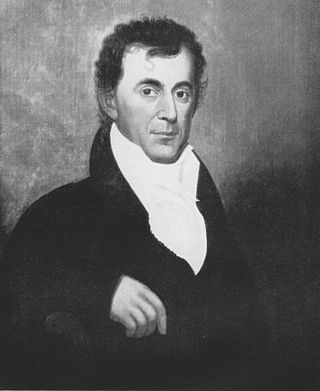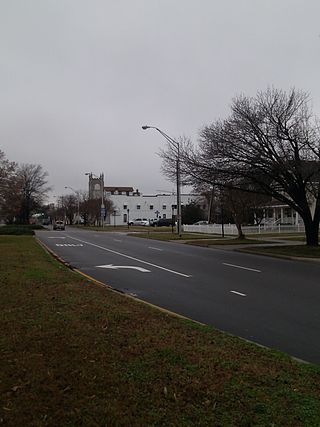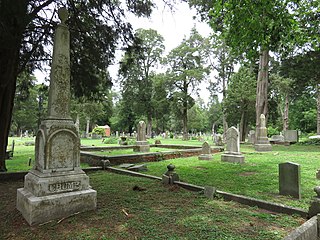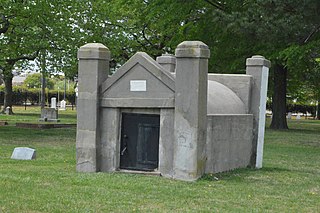
Courtland is an incorporated town in Southampton County, Virginia, United States. It is the county seat of Southampton County.

Littleton Waller Tazewell was a Virginia lawyer, plantation owner, and politician who served as U.S. Representative, U.S. Senator and the 26th Governor of Virginia, as well as a member of the Virginia House of Delegates.

Berkley was an incorporated town in Norfolk County, Virginia. Chartered by an Act of Assembly in 1890, the Town of Berkley was located directly across the Eastern Branch Elizabeth River from the City of Norfolk in the South Hampton Roads area.

The Minor Basilica of Saint Mary of the Immaculate Conception is a Black Catholic parish in downtown Norfolk, Virginia. It is the oldest parish in the Diocese of Richmond and is known locally as "The Mother Church of Tidewater Virginia".

Arlington House is the historic Custis family mansion built by George Washington Parke Custis from 1803–1818 as a memorial to George Washington. Currently maintained by the National Park Service, it is located in the U.S. Army's Arlington National Cemetery in Arlington County, Virginia. Arlington House is a Greek Revival style mansion designed by the English architect George Hadfield. The Custis grave sites, garden and slave quarters are also preserved on the former Arlington Estate.

Buildings, sites, districts, and objects in Virginia listed on the National Register of Historic Places:
Charles Emmett Cassell was a Baltimore, Maryland-based architect.

St. Patrick's Church is an historic Roman Catholic church in Glynwood, an unincorporated community in Moulton Township, Auglaize County, Ohio, United States. Located north of U.S. Route 33 between St. Marys and Wapakoneta, the church was built in 1883 in the Gothic Revival style. It is one of many large Catholic churches in a region of rural western Ohio known as the "Land of the Cross-Tipped Churches," which was settled by primarily Catholic immigrants during the nineteenth century.

St. Louis, Besancon, Historic District is a historic Roman Catholic church complex and national historic district located near New Haven in Jefferson Township, Allen County, Indiana. The district encompasses five contributing buildings and one contributing site consisting of the Saint Louis Besancon Roman Catholic Church and its cemetery and rectory. The Gothic Revival style church was built in 1870-71 of brick, fired in a nearby kiln, then covered with cement to give an appearance of stone. It features a steep gable roof and five part projecting square steeple. The rectory was built in 1893, and is a 2+1⁄2-story, Queen Anne style brick dwelling. The other contributing resources are the St. Louis Academy (1915), St. Louis Convent House (1915), garage (1940), and Old St. Louis Cemetery. The church was refurbished and painted in 1998.

St. Mary's Church is a historic Catholic church in the eastern United States, at Fairfax Station, Virginia, a suburb southwest of Washington, D.C. Built 166 years ago in 1858, it is a rectangular, one-story, gable-front, frame structure in the Gothic Revival style. It has a steeple at the entrance and a large Gothic arched window over the entrance door. St. Mary's was the first Catholic church built within Fairfax County, and its early parishioners were primarily Irish immigrants employed by the Orange and Alexandria Railroad.

Brightly is a historic plantation house located near Goochland, Goochland County, Virginia. The main dwelling was built about 1842, and is a two-story, single pile, central-passage-plan, gable-roofed brick dwelling in the Greek Revival style. The front facade features a one-story, one-bay Greek Revival Doric order porch. Also on the property are the contributing pair of slave dwellings, privy, granary, chicken house, barn, well house, windmill, cemetery and the gate posts.

Old Town Manassas, or the Manassas Historic District, is a national historic district located at Manassas, Virginia. It encompasses 206 contributing buildings and 1 contributing object in the central business district and surrounding residential area of city of Manassas.

Sunray Agricultural Historic District is a national historic district located at Chesapeake, Virginia. The district encompasses 188 contributing buildings, 90 contributing sites, 2 contributing structures, and 1 contributing object in the early 20th-century immigrant farming community of Sunray. It includes early 20th century vernacular farmhouses, agricultural buildings, Sunray School (1922), and St. Mary's Catholic Church (1915-1916). The district also includes a tidal ditch system, the abandoned Virginian Railway Tracks (1909), and agricultural fields laid out with the platting of 1908.

Washington Avenue Historic District is a national historic district located at Fredericksburg, Virginia. The district includes 36 contributing buildings, 1 contributing site, and 4 contributing objects in the city of Fredericksburg. It includes substantial, high-style residences that line both the east and the west sides of Washington Avenue reflect the various domestic styles that were popular at the turn of the 20th century. Notable dwellings include the Samuel W. Somerville House (1896-1897), Shepherd House (1910-1911), and Mary Washington Monument Caretaker's Lodge (1896). The four commemorative works are the Mary Washington Monument (1893), General Hugh Mercer Monument (1906) by Edward Virginius Valentine (1838-1930), Jefferson Religious Freedom Monument (1932), and the George Rogers Clark Memorial (1929). Located in the district is the separately listed Kenmore.

St. Vincent de Paul Catholic Church is a historic Catholic church complex in Newport News, Virginia, United States. It was built 1916–1917 and is a 1+1⁄2-story, brick, Classical Revival style longitudinal-plan church. It was designed by the Carl Ruehrmurd of Richmond, Virginia. The front facade features a pedimented portico with four fluted Corinthian order columns. Associated with the church are the contributing rectory (1917), garage (1917), and prayer garden. The parish was established as a mission of the St. Mary Star of the Sea Church at Old Point Comfort in 1881. St. Alphonsus, an African American parish established in 1944, was merged with St. Vincent de Paul in 1970. This made it the first historic church in downtown Newport News to be racially integrated.

St. John's AME Church is a historic congregation of the African Methodist Episcopal Church in Norfolk, Virginia, United States. Founded in 1840, it was the first African American Episcopal Church in Virginia. It moved to its present location on East Bute Street in what is now Downtown Norfolk in 1848.

West Point Cemetery, also known as Potter's Field and Calvary Cemetery, is a historic cemetery and national historic district located at Norfolk, Virginia. It encompasses three contributing sites, one contributing structure, and one contributing object in an African American graveyard in downtown Norfolk. The cemetery was established in 1873, and includes a grouping of headstones marking the remains of 58 black soldiers and sailors who served in the American Civil War, and a monument honoring these veterans stands over their graves. Other notable elements include the Potter's Field, O’Rourke Mausoleum, and the West Point Cemetery entry sign.
Norfolk and Western Railway Freight Station is a historic freight depot located in the Melrose-Rugby neighborhood of Roanoke, Virginia. It encompasses 111 contributing buildings and 2 contributing objects in a planned residential subdivision, with most of the dwellings being built between the late 1910s and late 1940s. It is a primarily residential district with single-family dwellings. The houses include American Craftsman-style bungalow, American Foursquare, and Cape Cod style. The building houses the Virginia Museum of Transportation

Cedar Hill Cemetery, also known as Green Hill Cemetery, is a historic cemetery and national historic district located at Suffolk, Virginia. The district encompasses four contributing structures, one contributing site, and three contributing objects in the a city-owned, 25-acre, public cemetery dating to 1802. Grave markers within the cemetery date from the early 19th century to the present day. This cemetery is a representative example of public cemetery planning and funerary artwork found in southeast Virginia and Suffolk. The contributing structures include the Darden (1938), Hosier, Hill (1933) and Brewer-Godwin mausoleums and the contributing objects include the Confederate Monument (1889) and World War I Monument.

Elmwood Cemetery is a historic municipal cemetery located at Norfolk, Virginia. It was established in 1853, and is filled with monuments and mausoleums that embody the pathos and symbolism of the Christian view of death as a temporary sleep. A notable monument is the Recording Angel by William Couper (1853–1942) at the Couper Family plot. The Core Mausoleum (1910–1915) designed by Harold Van Buren Magonigle (1867–1935), with sculptures by Edward Field Sanford, Jr. (1886–1951), is another notable resource.






















